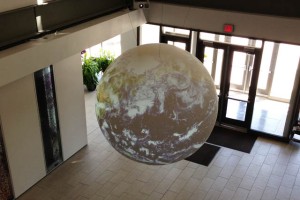“LEED (Leadership in Energy and Environmental Design) is a program that provides third-party verification of green buildings. Building projects satisfy prerequisites and earn points to achieve different levels of certification. It is a green building tool that addresses the entire building lifecycle recognizing best-in-class building strategies”(US Green Building Council).
I got a chance to take a tour of the newly built Cyber Infrastructure Building (CIB) on the Indiana University – Bloomington campus. It has been rated 74/110 in the LEED rating based on Sustainable site, water efficiency, energy and atmosphere, materials and resources used, indoor environmental quality, innovation and regional priority.
It was a very weird experience where I felt as if technology was the way to get closer to nature. They have constructed a technologically advanced building with a very less carbon footprint.
At the entrance there is a globe surrounded by 4 projectors which projected the global daily updates, which I thought was very cool!
We were first taken outside the building to show us the parking facility which was very compact, space saving and priority was given to energy efficient and electric vehicles (they had a special parking). They also had a location where they may set up charging points for the electric cars.
Cycling is greatly encouraged and there was a cycle storage room inside the building which accommodated up to 35 bikes. The room also had other cycling tools. This greatly helps reduce the carbon emissions.
The building is designed to conserve space and thus conserve energy in all the ways possible. Even the cabins of the people with higher posts were made smaller to reduce wastage. There were specific printers on each floor which had to be used by the employees, which reduced the paper wastage and also helped conserve electricity. Most of the data was digitized and paper usage was minimized.
- Small Cabins
One of the best parts of the tour for me was when the guide mentioned that the ceiling of one of the conference rooms was made from recycled t-shirts!!
The centralized heating system used at CIB, was not new and was a reused system, which is a great idea to decrease production costs and construction costs.
The sunshades used were specially designed to maximize the usage of solar energy to heat and light up the building. They also had solar panels for hot water on top of one of the buildings. The design was very innovative and they had special rooms for people to hang out and develop creative ideas.
Recycling is greatly encouraged and there are recycling bins placed at varied locations throughout the building.
It was a very hands-on experience I got from what I learn in the Sustainable Communities course and will surely be valuable throughout my career.
LEED-India & GRIHA – Green building rating in India
India started to mirror the global trend when LEED-India Programme was adapted from United States Green Building Council’s LEED. This is a private initiative which is run by the Indian Green Building Council (IGBC) in India. The IGBC (Indian Green Building Council) mentions that LEED-India works on a whole-building approach to sustainability by recognizing performance and efficiency in the five key areas namely sustainable site development, water savings, energy efficiency, materials selection and indoor environmental quality.
The alternative system is GRIHA which stands for ‘Green Rating for Integrated Habitat Assessment’. It has been conceived by ‘The Energy and Resources Institute’ (TERI) in India and jointly developed by Ministry of New and Renewable Energy (MNRE) as the national rating system for buildings. It is a green building ‘design evaluation system’, and is suitable for all kinds of buildings in different climatic zones of India. . It is a 100 point system with a set of 34 criteria. Some of them are mandatory. Minimum qualifying score to qualify is 50 and the rating is given in 1-5 stars, 1 star for every 10 points over 50.
Both GRIHA and LEED-INDIA are operating at the national (in India) level. Both these ratings have a checklist of criteria and points that are assigned to these criteria based on their relative importance.
A wide range of rating systems have developed in different parts of the world based on local climates and geographical conditions.
Thus based on such rating systems, we can develop greener futures for our communities.
References:
(2012). Green-building rating: Overrated. Centre for Science and Environment, Retrieved from http://www.cseindia.org/userfiles/green_building_rating.pdf
GRIHA. (n.d.). Green rating for integrated habitat assessment. Retrieved from http://www.grihaindia.org/index.php?option=com_content&view=article&id=73
Related articles
- LEED v 4, a “quantum leap” for green building (iusustain.wordpress.com)






